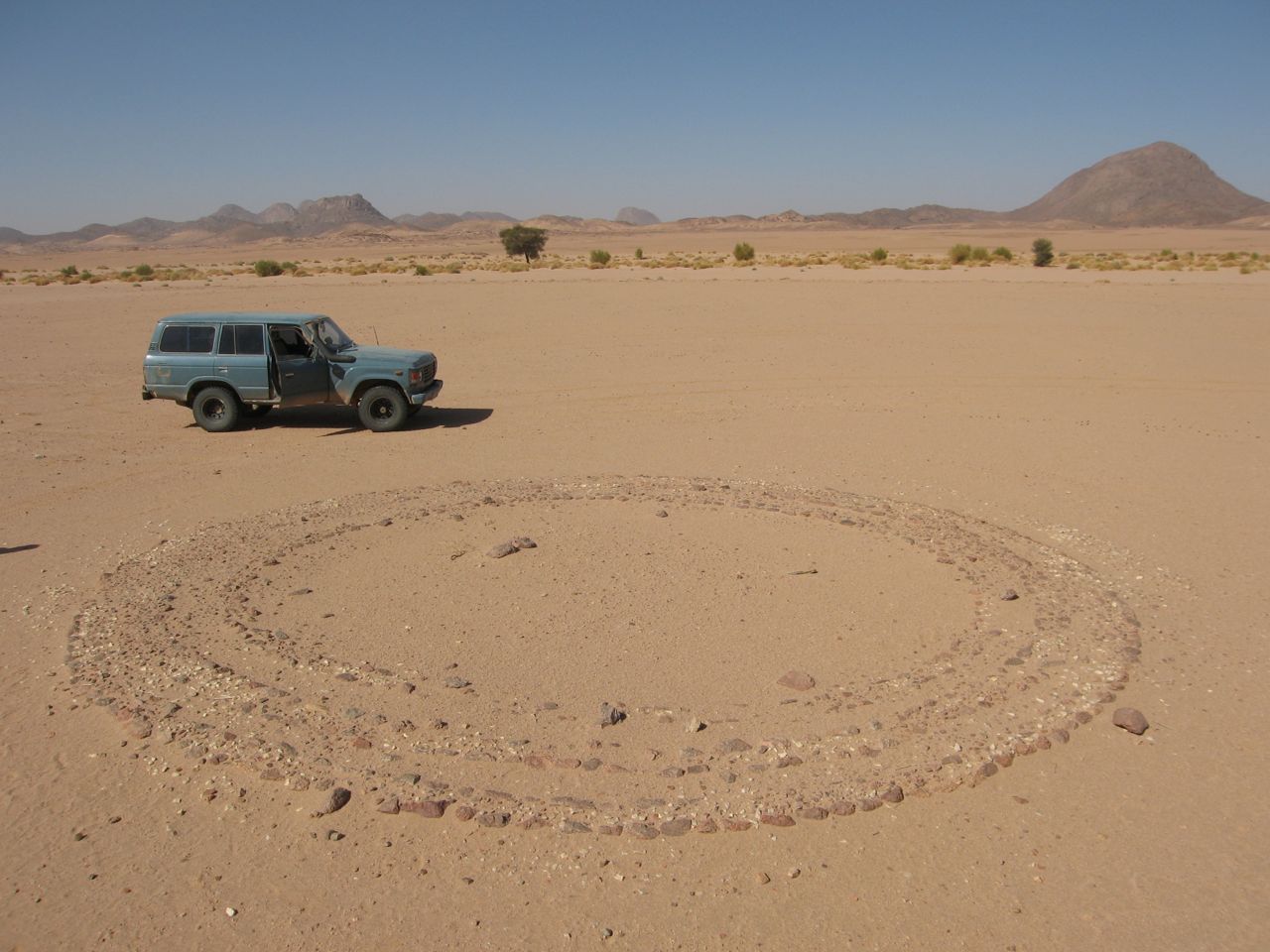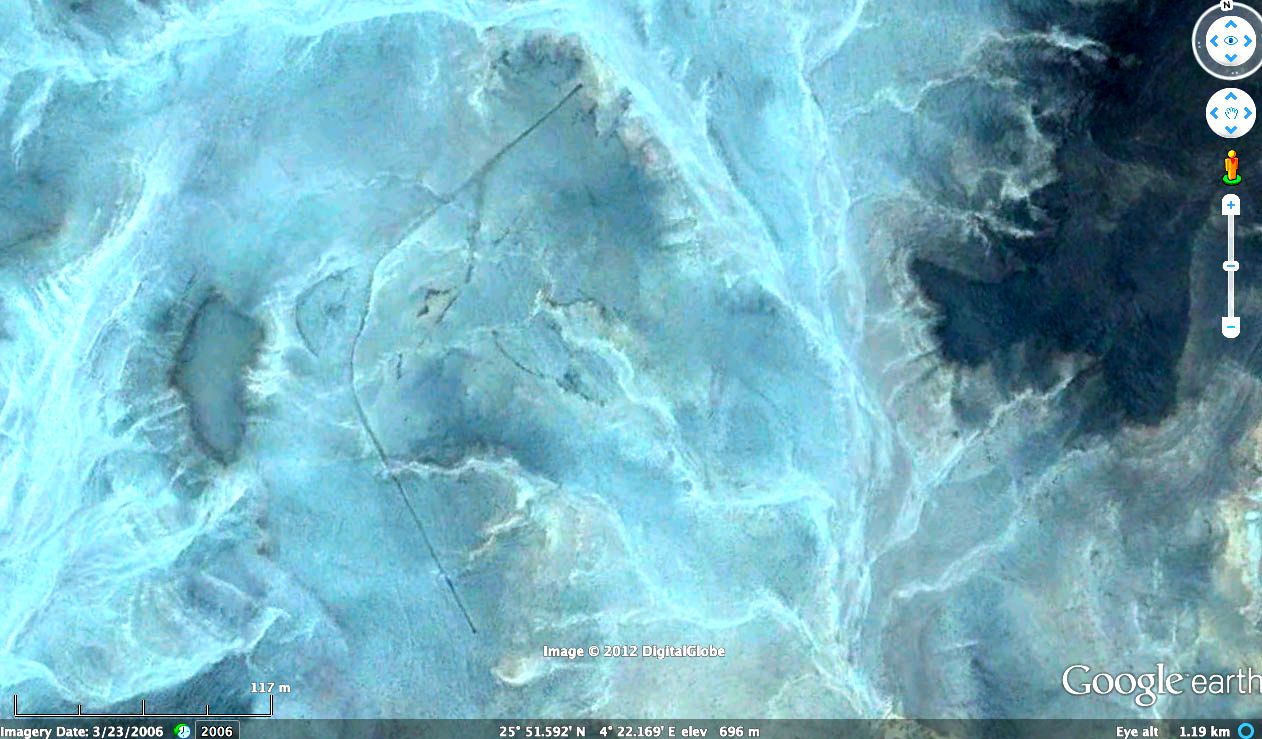Part of the Sahara A to Z series
See also:
Mysterious circles
Interesting academic document
More interesting Sahara tombs on GEC
Nick Brooks’ photos (Western Sahara)
As on previous occasions, the route of our camel trek through the Immidir will rest a day at Aguelmam Rahla, a reliable waterhole at the mouth of the Oued Tafrakrek canyon (blue line on map, left) where the Tissedit plateau drops down to meet a band of dunes. I’d been wanting to make a diversion here since scanning Google Earth a few years back and noticing the innumerable pre-Islamic tombs (‘PIZ’) in the area (below).
Looking again on Google Earth some time later, less than an hour of nosing around revelled three dozen keyhole, antenna or crescent tombs within a few kilometres of the waterhole. I didn’t bother counting the less distinctive ‘mound’ tombs. In fact the proliferation of tombs here isn’t so unusual given the topographic features already listed: edge of a plateau, former river mouth, band of dunes – all common factors adding up to a Neolithic occupation site.

On the first crater tour in 2007 we walked along the base of the dunes, northeast from Aguelmam Rahla, and discovered several grinding stones and other artefacts at the foot of the dunes. And in 2012 one of us came across a near intact pot (left) at the foot of a dune as well as napping (stone tool chipping) sites.
There’s something compulsive about Sahara tomb spotting on Google Maps, searching the featureless desert floor for the clear signs of prehistoric human activity. Once out there it gives a purpose to a journey that’s otherwise just agreeable recreation and adds a hint of treasure hunting. It reminds you that the Sahara of 6000 years ago was not a desert, but a much less arid savannah. As mentioned in the Mark Milburn book review, among others, KenGrok has spent hours and years scanning and collating Google Earth’s imagery to identify unusual things, including pre-Islamic tombs in the Sahara. In 2019 Google erased his work but it seems his baton has been picked up by ‘syzygy‘ on Google Earth Community.
Often this fascination and excitement falls a little flat on actually finding a tomb on the desert floor. On the 2012 trip I was excited about finding a huge antenna tomb that lay close our path on Day 6 or so. On GE (above) the massive structure with a ring-angle span of over 300m looked amazing, but by the time we tracked it down it (left) was too big to appreciate from ground level. My group seemed to say… ‘and the purpose if this diversion was…?’. ‘Flying’ over these tombs on satellite imagery, like Peru’s Nazca lines, is how they’re best appreciated.
FYI: Google Earth was the original wonder but resolution is comparatively poor, at least in the Sahara. ZoomEarth offers a live view, but when you zoom right in appears to use the same superior resolutionj imagery as (Microsoft) Bing Maps Aerial.
How old are these ‘pre-Islamic’ tombs? Well in the central Sahara I’d say the Islamic era began to have an impact a couple of hundred years after the Arab Conquest of North Africa between AD 647–709. I imagine this swept like a tide west along the south Mediterranean coast, down the Atlantic to present-day Mauritania and then ‘eddied’ back west towards places like Timbuktu. Other eddies may have spun off sooner to places like Ghadames in Libya, following trans-Saharan trade routes into the interior.
Chances are these tombs, like the huge keyhole on the right in the Immidir (middle left of the picture; some 60m across), are only around 3000 years old, maybe double that. That means they followed the apogee of rock art some 6000 years ago following a climate change (the ‘Humide’ in the image below) which briefly repopulated populated what is now the Sahara. By this time megalithic tombs became widespread across the ancient world, most spectacularly in ancient Egypt.

What’s interesting is the orientation of these tombs is almost always towards the east; you may have noticed that by looking closely at the link above. Be it a keyhole with a ‘walkway/slot’ or the open arms of an antenna, the orientation is always eastwards within the range of the rising sun, according to the diagram, left, with concomitant suggestions of ‘rebirth’ and afterlife.

You don’t have to venture into the deep Sahara to see keyhole tombs. In southern Morocco, just a short distance from Erg Chebbi and three miles west of Taouz, on the west side of the Oued Ziz are a cluster of tombs. Like Aguelmam Rahla they’re situated on the edge of a plateau and by a former big river as well as an erg – and not all with entrance ways pointing east.

Below, a curious structure on the Oued Tagant valley midway between Tam and Djanet. And below that, another in the Hoggar, just southeast of Assekrem. I’ve seen these elsewhere in southern Algeria but their meaning is unknown. The guides and old Saharan expeditions just call them ‘tombs’ but they look different and newer than PIZs.
More here.















Pingback: The Mummy film in Morocco - Horizons Unlimited - The HUBB
Pingback: Algerian Sahara Camel Trek (video) | Sahara Overland
Pingback: ‘M’ is for the Mysterious Circle of Adrar Madet | Sahara Overland
Fascinating! Just watched Vox’s video on exploring interesting rings in Algeria which then led me here. On the way they passed several tombs in the middle of the Sahara. I wonder if they’ve ever been excavated and if anything has been found or if its all decayed into sand.
LikeLike
Hi Brennan, I have never heard of anything more than maybe bones, far less artefacts being dug up from these tombs. One might assume they have been robbed, but one time in the Gilf (Egypt) someone did decide to dig up a tomb we passed walking in a very remote locale (we may have been the first there) and found nothing. Perhaps a couple of millenia is all it takes. The only successful excavation I know of was ancestral Tuareg queen, Tin Hinan at Abalessa near Tam, in the 1930s and the tomb is only 1000 years old.
See; https://sahara-overland.com/2012/09/04/book-review-mysterious-sahara-byron-khun-de-prorok/
LikeLike
This is fascinating thank you for this write up. I had to give it a go and think I found some burial sites in Egypt if you could have a look and let me know I would be greatly appreciative.
28°56’55.66″N, 30°13’21.03″E
LikeLike
Thanks Braden. They are fascinating even though we also have similar all over southern England, except they’re now covered by farmland.
I looked you waypoint up and have to say it looks like a natural, crater-like limestone formation to me. But when you spot one you will know for sure. As said in the article, the location of the tombs is often (but not always) predictable; by the mouth of a big canyon (former river) where settlements would have developed.
LikeLike